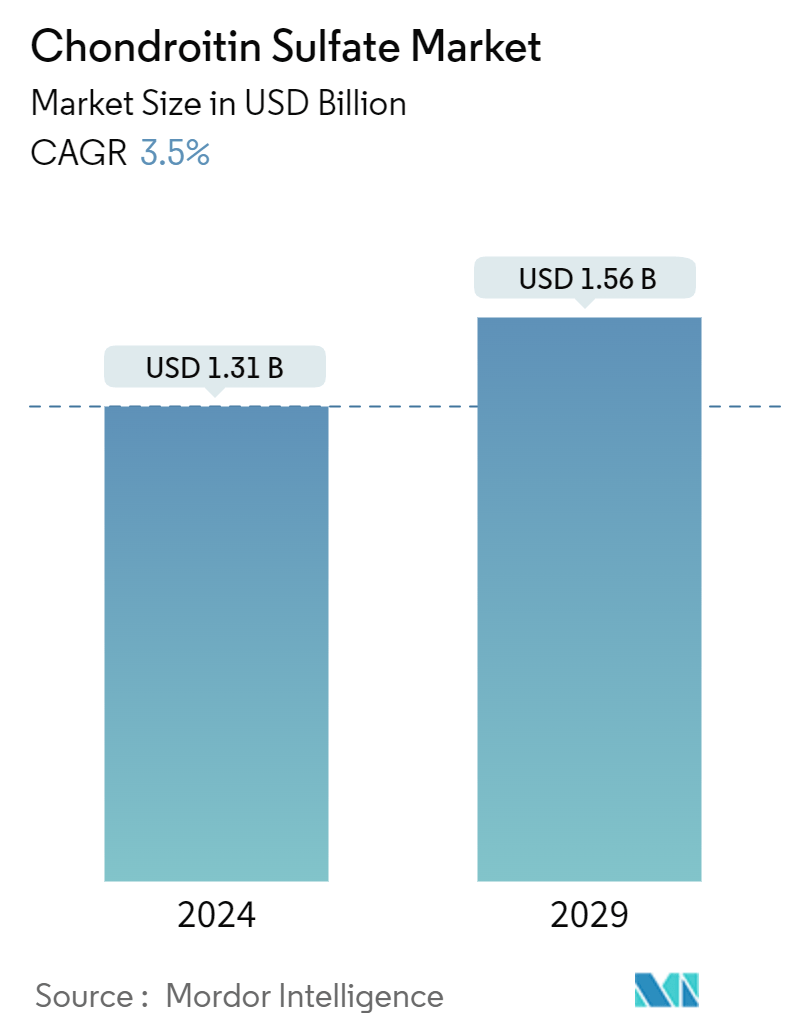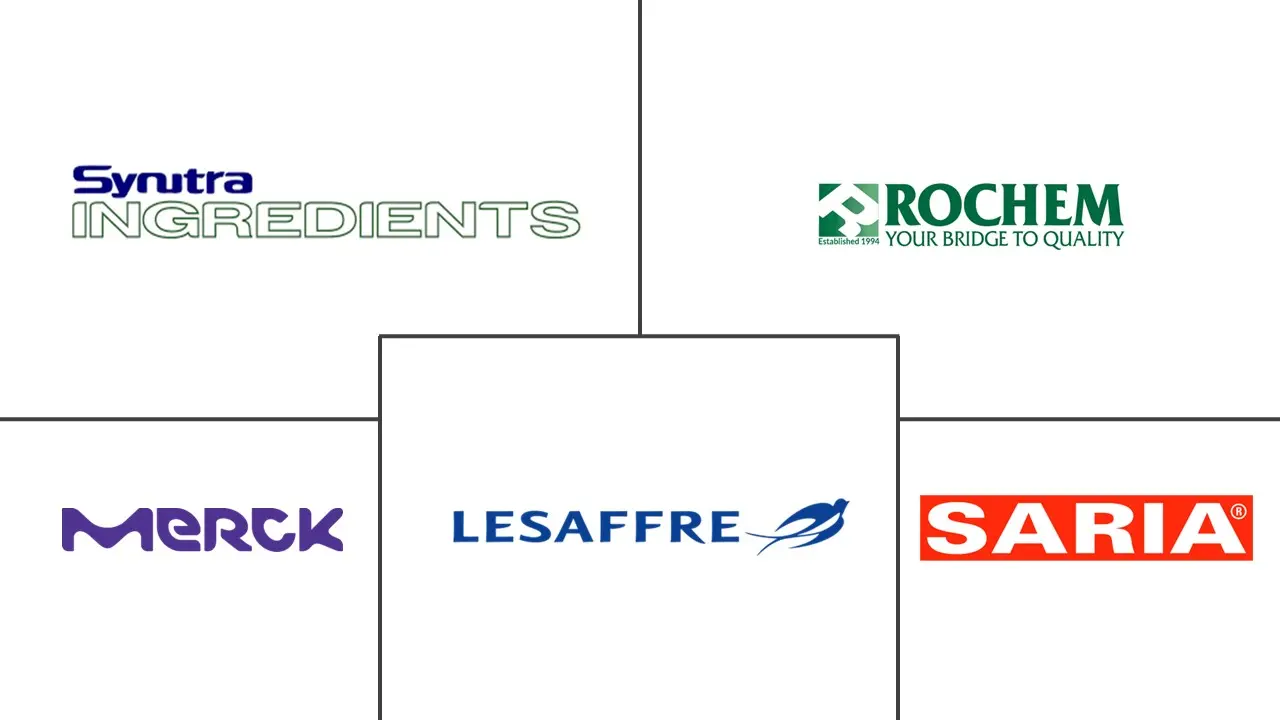Market Size of Chondroitin Sulfate Industry

| Study Period | 2019 - 2029 |
| Market Size (2024) | USD 1.31 Billion |
| Market Size (2029) | USD 1.56 Billion |
| CAGR (2024 - 2029) | 3.50 % |
| Fastest Growing Market | Asia-Pacific |
| Largest Market | North America |
Major Players
*Disclaimer: Major Players sorted in no particular order |
Chondroitin Sulfate Market Analysis
The Chondroitin Sulfate Market size is estimated at USD 1.31 billion in 2024, and is expected to reach USD 1.56 billion by 2029, growing at a CAGR of 3.5% during the forecast period (2024-2029).
The COVID-19 pandemic disrupted the chondroitin sulfate supply chain, making it difficult for companies to obtain the raw materials they needed to make the product. For instance, according to the article published by BioMed Central in April 2023, the COVID-19 pandemic led to an increase in malnutrition among the most vulnerable children and disrupted food and nutritional API supply chain systems, including chondroitin sulfate APIs. Thus, the pandemic led to shortages of chondroitin sulfate API, which, in turn, led to increased prices, thereby making it difficult for companies to produce and sell chondroitin sulfate-containing products.
Furthermore, the COVID-19 pandemic led to increased research studies on the potential antiviral properties of chondroitin sulfate, which is projected to drive market growth during the forecast period. For instance, a research study published by the Viruses Journal in February 2022 investigated the potential antiviral effects of high-sulfated glycosaminoglycan (GAG) derivatives, including chondroitin sulfate (CS), against coronaviruses, including SARS-CoV-2. Therefore, looking at the overall scenario, the COVID-19 pandemic substantially impacted the market in its initial phases, owing to supply chain disruptions leading to Chondroitin sulfate API shortages and subsequently increased prices. However, increased research into the potential antiviral properties of Chondroitin sulfate and the exploration of its use in new indications after SARS-CoV-2 infection has driven research and investment in this area.
The significant factors contributing to the growth of the chondroitin sulfate market over the forecast period include the rising occurrence of osteoarthritis cases, which are usually treated with chondroitin sulfate, and the increasing applications of chondroitin sulfate in various sectors. For instance, according to the data released by the World Health Organization (WHO) in July 2023, about 73% of people living with osteoarthritis are older than 55 years, and 60% are female.
In addition, the rising prevalence of osteoarthritis of knees and hands coupled with the increasing aging population and obesity is also projected to drive market growth during the forecast period. For instance, according to the data published by the Institute for Health Metrics and Evaluation (IHME) in August 2023, approximately 1 billion people worldwide are projected to suffer from osteoarthritis by the end of 2050, primarily due to the rising obesity cases. Moreover, according to the data released by the World Health Organization (WHO) in July 2023, about 73% of people living with osteoarthritis are older than 55 years, and 60% are female. Therefore, the high prevalence of osteoarthritis in the aging population is projected to drive market growth during the forecast period. Therefore, the high prevalence of osteoarthritis in the aging population is projected to drive market growth during the forecast period.
With an aging global population, joint-related health issues like osteoarthritis are more prevalent. The demand for Chondroitin sulfate as a supplement for joint health is expected to rise as more elderly individuals seek ways to maintain mobility and manage joint discomfort. For instance, the geriatric population in the European Union (EU) is increasing at a rapid pace. For instance, as per the article published by the World Economic Forum in September 2022, more than 30% of the EU population is expected to be 65 or older by 2100. Therefore, the surging geriatric population in different regions of the world is projected to drive market growth during the forecast period.
Actions by key market players to develop the pharmaceutical segment of chondroitin sulfate are expected to boost market growth. For instance, in March 2022, Livisto launched HYALUTIDIN DC, a nutraceutical product for osteochondrosis in dogs and cats in Egypt. HyalutidinDC is an oral solution composed of hyaluronic acid and chondroitin sulfate with high palatability.
Therefore, the increasing incidence of osteoarthritis and strategic activities by market players are anticipated to drive market growth during the forecast period. However, the adverse effects of chondroitin sulfate are a major factor hindering market growth.
Chondroitin Sulfate Industry Segmentation
As per the scope of the report, chondroitin sulfate is a glycosaminoglycan and is a major component of the extracellular matrix (ECM) of many connective tissues, including cartilage, bone, skin, ligaments, and tendons. In supplements, chondroitin sulfate usually comes from animal cartilage. The chondroitin sulfate market is segmented by source (swine, shark, bovine, synthetic, and others), application (pharmaceuticals, cosmetics, and veterinary), and geography (North America, Europe, Asia-Pacific, Middle East and Africa, and South America). The report offers values (in USD) for the segments mentioned above. The market report also covers the estimated market sizes and trends for 17 different countries across major regions globally. The report offers values (in USD) for the segments mentioned above.
| By Source | |
| Swine | |
| Shark | |
| Bovine | |
| Synthetic | |
| Other Sources |
| By Application | |
| Pharmaceuticals | |
| Cosmetics | |
| Veterinary |
| By Geography | ||||||||
| ||||||||
| ||||||||
| ||||||||
| ||||||||
|
Chondroitin Sulfate Market Size Summary
The chondroitin sulfate market is poised for growth over the forecast period, driven by increasing demand for joint health supplements, particularly among the aging population. The market has experienced disruptions due to the COVID-19 pandemic, which affected the supply chain and led to shortages and price increases. However, the pandemic also spurred research into the antiviral properties of chondroitin sulfate, potentially opening new avenues for its application. The rising prevalence of osteoarthritis, especially among older adults and those with obesity, is a significant factor propelling market expansion. Chondroitin sulfate is widely used in the treatment of osteoarthritis, and its demand is expected to rise as more individuals seek to manage joint pain and maintain mobility.
In addition to its therapeutic applications, chondroitin sulfate is gaining traction in various sectors, including pharmaceuticals and veterinary medicine. The market is characterized by strategic activities from key players, such as product launches and partnerships, which are expected to enhance market offerings and drive competition. North America is anticipated to witness substantial growth due to the high prevalence of arthritis and the increasing geriatric population. The fragmented nature of the market, with several global and regional players, suggests a competitive landscape that may lead to innovations and improved product formulations. Overall, the chondroitin sulfate market is set to grow, supported by demographic trends, research advancements, and strategic market initiatives.
Chondroitin Sulfate Market Size - Table of Contents
-
1. MARKET DYNAMICS
-
1.1 Market Overview
-
1.2 Market Drivers
-
1.2.1 Increasing Prevalence of Osteoarthritis
-
1.2.2 Growing Applications of Chondroitin Sulfate
-
-
1.3 Market Restraints
-
1.3.1 Adverse Effects of Chondroitin Sulfate
-
-
1.4 Porter's Five Force Analysis
-
1.4.1 Threat of New Entrants
-
1.4.2 Bargaining Power of Buyers/Consumers
-
1.4.3 Bargaining Power of Suppliers
-
1.4.4 Threat of Substitute Products
-
1.4.5 Intensity of Competitive Rivalry
-
-
-
2. MARKET SEGMENTATION (Market Size by Value - in USD million)
-
2.1 By Source
-
2.1.1 Swine
-
2.1.2 Shark
-
2.1.3 Bovine
-
2.1.4 Synthetic
-
2.1.5 Other Sources
-
-
2.2 By Application
-
2.2.1 Pharmaceuticals
-
2.2.2 Cosmetics
-
2.2.3 Veterinary
-
-
2.3 By Geography
-
2.3.1 North America
-
2.3.1.1 United States
-
2.3.1.2 Canada
-
2.3.1.3 Mexico
-
-
2.3.2 Europe
-
2.3.2.1 Germany
-
2.3.2.2 United Kingdom
-
2.3.2.3 France
-
2.3.2.4 Italy
-
2.3.2.5 Spain
-
2.3.2.6 Rest of Europe
-
-
2.3.3 Asia-Pacific
-
2.3.3.1 China
-
2.3.3.2 Japan
-
2.3.3.3 India
-
2.3.3.4 Australia
-
2.3.3.5 South Korea
-
2.3.3.6 Rest of Asia-Pacific
-
-
2.3.4 Middle East and Africa
-
2.3.4.1 GCC
-
2.3.4.2 South Africa
-
2.3.4.3 Rest of Middle East and Africa
-
-
2.3.5 South America
-
2.3.5.1 Brazil
-
2.3.5.2 Argentina
-
2.3.5.3 Rest of South America
-
-
-
Chondroitin Sulfate Market Size FAQs
How big is the Chondroitin Sulfate Market?
The Chondroitin Sulfate Market size is expected to reach USD 1.31 billion in 2024 and grow at a CAGR of 3.5% to reach USD 1.56 billion by 2029.
What is the current Chondroitin Sulfate Market size?
In 2024, the Chondroitin Sulfate Market size is expected to reach USD 1.31 billion.

